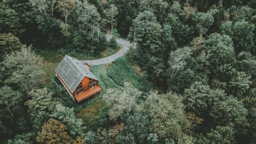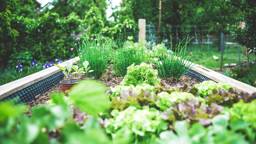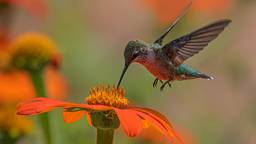Having a natural, healthy shoreland is one of the best things that can happen to your lake or river. It improves the vitality of life both above and below the water and it makes for a beautiful vista for everyone to enjoy.
The shoreland is composed of three general areas: the upland area that goes from your property down to the lake, the shoreline, and the shallow area out to about the end of your dock. These three areas are the keys to a beautiful and bustling shoreland.
How do you know if your shoreland is healthy and thriving? Here’s what to look for:
Emergent Plants
Sedges, bulrushes and cattails not only provide habitat for a variety of birds and upland animals, but in shallow water they send oxygen down their hollow stems to help with root respiration. These oxygenated root zones also support high-quality aquatic insect communities (including dragonfly larvae).
Dragonfly Zones
Want to produce a natural mosquito-eating system? The key may be dragonflies! Dragonfly larvae feed on mosquito larvae. And then as adults, dragonflies become voracious predators of adult mosquitos. Dragonfly larvae mature in lake sediments, and after a year or two, they emerge from the lake and hang around the shoreline. Make sure the shoreline vegetation includes tall emergent plants.
Coarse Woody Habitat
When a tree falls into the lake from the shoreline it creates instant habitat and structure for a variety of aquatic species – which should be music to any fisherman’s ears. This type of structure can last for a hundred years, and it’s okay to leave it in the lake. Lakeshores in uninhabited lakes in the far north average about one downed tree for every 6 feet of shoreline. As development has increased around lakes, there has been a tendency to remove coarse woody material, but if you can tolerate a few here and there, there are big benefits.
The shoreland is composed of three general areas: the upland area that goes from your property down to the lake, the shoreline, and the shallow area out to about the end of your dock. These three areas are the keys to a beautiful and bustling shoreland.
How do you know if your shoreland is healthy and thriving? Here’s what to look for:
Emergent Plants
Sedges, bulrushes and cattails not only provide habitat for a variety of birds and upland animals, but in shallow water they send oxygen down their hollow stems to help with root respiration. These oxygenated root zones also support high-quality aquatic insect communities (including dragonfly larvae).
Dragonfly Zones
Want to produce a natural mosquito-eating system? The key may be dragonflies! Dragonfly larvae feed on mosquito larvae. And then as adults, dragonflies become voracious predators of adult mosquitos. Dragonfly larvae mature in lake sediments, and after a year or two, they emerge from the lake and hang around the shoreline. Make sure the shoreline vegetation includes tall emergent plants.
Coarse Woody Habitat
When a tree falls into the lake from the shoreline it creates instant habitat and structure for a variety of aquatic species – which should be music to any fisherman’s ears. This type of structure can last for a hundred years, and it’s okay to leave it in the lake. Lakeshores in uninhabited lakes in the far north average about one downed tree for every 6 feet of shoreline. As development has increased around lakes, there has been a tendency to remove coarse woody material, but if you can tolerate a few here and there, there are big benefits.
Docks & Lifts
The equipment used to manage watercraft along a shoreline is viewed by largemouth bass as shade and structure. The key is a balance between enough docks and lifts for your family and boats, but not so many that they shade out aquatic plants, which can potentially create an ecological chain reaction that affects fish and other species in your lake or river.
Groundwater Inflow Area
Have you ever swam into a spot of cold water on a warm summer day? That was a spring or, to put it another way, an area of concentrated groundwater inflow. More typically, groundwater enters a lake slowly, moving horizontally at perhaps only 1 foot per day, into the nearshore zone. Typically the flow is so slow that we don’t sense it, but fish can. When trout are spawning in streams they are looking for those inflows. In lakes, sunfish may build their nests over areas of groundwater inflows.
Nurseries for Young Fish
The aquatic plants in the shallow water around a shoreline offer a place for a thriving aquatic insect community. The aquatic plant beds, in turn, provide cover and a food source for young fish.
Hunting Grounds for Big Fish
At night, big fish are cruising the shallows looking for the little fish. Instead of casting off the end of the dock into deep water, turn around and try casting into the shallow water. The big fish are there at night.
Swimming Areas
Can swimming areas coexist with good lake shoreland habitat? Sure they can. Your nearshore area can accommodate reasonable swimming zones along with maintaining other natural areas. Often, a 50 foot by 50 foot swimming area will be sufficient. After all, having your very own swimming hole is one of the reasons to live on a lake But don’t forget to provide natural areas to keep your lake healthy.
Steve McComas (aka The Lake Detective) has been working on lakes for 30 years.
The equipment used to manage watercraft along a shoreline is viewed by largemouth bass as shade and structure. The key is a balance between enough docks and lifts for your family and boats, but not so many that they shade out aquatic plants, which can potentially create an ecological chain reaction that affects fish and other species in your lake or river.
Groundwater Inflow Area
Have you ever swam into a spot of cold water on a warm summer day? That was a spring or, to put it another way, an area of concentrated groundwater inflow. More typically, groundwater enters a lake slowly, moving horizontally at perhaps only 1 foot per day, into the nearshore zone. Typically the flow is so slow that we don’t sense it, but fish can. When trout are spawning in streams they are looking for those inflows. In lakes, sunfish may build their nests over areas of groundwater inflows.
Nurseries for Young Fish
The aquatic plants in the shallow water around a shoreline offer a place for a thriving aquatic insect community. The aquatic plant beds, in turn, provide cover and a food source for young fish.
Hunting Grounds for Big Fish
At night, big fish are cruising the shallows looking for the little fish. Instead of casting off the end of the dock into deep water, turn around and try casting into the shallow water. The big fish are there at night.
Swimming Areas
Can swimming areas coexist with good lake shoreland habitat? Sure they can. Your nearshore area can accommodate reasonable swimming zones along with maintaining other natural areas. Often, a 50 foot by 50 foot swimming area will be sufficient. After all, having your very own swimming hole is one of the reasons to live on a lake But don’t forget to provide natural areas to keep your lake healthy.
Steve McComas (aka The Lake Detective) has been working on lakes for 30 years.
Mother Nature
If there is a question about how the shoreland should look, here is a little trick to consider. Visit an undeveloped shoreland and observe the natural upland vegetation, the submerged plants and even the beach slopes. Take some pictures and use these observations to apply the best attributes of the natural shoreland to your shoreland. In these situations, Mother Nature is the teacher.
If there is a question about how the shoreland should look, here is a little trick to consider. Visit an undeveloped shoreland and observe the natural upland vegetation, the submerged plants and even the beach slopes. Take some pictures and use these observations to apply the best attributes of the natural shoreland to your shoreland. In these situations, Mother Nature is the teacher.
 Tanya Bäck
Tanya Bäck  Tanya Bäck
Tanya Bäck  Tanya Bäck
Tanya Bäck 









